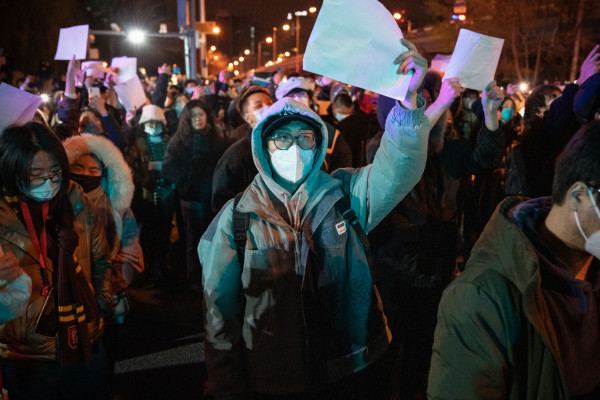

Events in China over the past few days have been a culmination of what has been a very challenging couple of years for the world’s second largest economy.
The fall from grace was initially driven by regulatory crackdowns, with China’s ruling party flexing its muscles and reminding everyone who is in charge, as the technology and education sectors came under fire.
But it is the heavily enforced – and growth-inhibiting – Covid-19 zero policy that seems to have finally seen patience snap among the population, resulting in large demonstrations and an unprecedented challenge to President Xi Jinping.
These protests have now spread to some of the biggest cities, with police detaining some of the protestors.
Further concerns include the deliberate clampdown on property development – resulting in a severe liquidity crunch – and geopolitical tensions, notably with the US, leading to worries that productivity growth might slow.
There are also fears that foreign direct investment may be reduced, particularly among sectors that are seen to be sensitive to national security.
Of course, we are also in the midst of a slowdown in growth in China – something that is not helped by the ageing population. The economy grew by 6.7 per cent in the past decade, but growth is now expected to be closer to 3 per cent at the end of the next one.
The coupling of political risks and slowing structural growth rates has created a huge wave of negative sentiment towards the region.
However, there are some positives to remember – not least that it is the only major economy continuing to focus on financial easing while much of the world is tightening.
You also have to consider that Chinese households have been saving since the start of the pandemic, with family bank balances up 42 per cent since the start of 2020 – the money is there to fuel a consumer rebound.
Since February 2021, the market has fallen almost 50 per cent, making it undoubtedly cheap versus its peers and its own recent history. In these difficult times we often look for a catalyst for change, but perhaps we have already seen a turning point for the Chinese economy.
Patience needed – but it is wearing thin
We recently saw China’s 20th Party Congress take place – it occurs every five years to unveil the mid to long-term policy agenda and reshuffle its leadership.
The salient points were that economic growth remains China’s top priority – with the hope of growing China to an income level on par with medium-sized developed countries by 2035.
It also took aim at the aforementioned triumvirate of challenges facing the economy – Covid-zero, the battered property sector and geopolitics.
We will start with Covid – where 20 measures have been put in place to bring some sense of normality to China and prompt an economic recovery.
These include: stopping the tracking of people with minor exposure to Covid cases; reducing those going into quarantine; easing of rules for high-risk cities and towns; and promotion of vaccination amongst the elderly. Attempts are also being made to make it easier to visit from abroad.
But, as the past few days have indicated, things may get worse before they get better. The country developed its own vaccines, which are simply not as good as the Pfizer or Moderna offerings, and new variants have been spreading faster.
China will do anything to see a repeat of the early days of the pandemic and the winter months indicate more vigilance is on the way.
Matthews Asia investment strategist Andy Rothman says the new policy direction was extremely clear but investors should expect a bumpy road to the end of lockdowns from here.
He says: “There will be more lockdowns in the coming months as well as reports of local officials failing to follow the new policy guidance. As a result, economic data is likely to remain weak through the winter.
"The end of lockdowns is not likely until the spring, which should be followed by a gradual economic recovery in the second half of the year.”
That uncertainty is reflected by the recent events. After an initial fall in markets on Monday (Nov 28) the Hang Seng China Enterprises Index and the CSI 300 (the 300 largest listed China A shares) started recovering some of their losses throughout the day.
A recent update from AllianzGI also pointed out that stocks seen as reopening beneficiaries – hotels, airlines, duty free shopping, Macau casino operators etc – were in positive territory for most of the day and generally rallied by 2 per cent to 3 per cent on average.
The firm added that the market's interpretation is that some type of “de facto reopening now appears at hand”.
With property construction driving more than 20 per cent of economic growth in recent years, this has further depressed economic activity and market earnings.
However, a further 16 measures were introduced on November 11 to help reinvigorate the residential property market.
The measures include credit support for debt-laden housing developers, financial support to ensure the completion and handover of projects to homeowners, and assistance for deferred-payment loans for homebuyers.
It is hoped the move will pre-empt a gradual recovery in home sales in 2023.
There is also hope that a recent meeting between President Xi and US President Joe Biden can quell the worsening geopolitical tensions between the two superpowers.
Both have commented on the success of the meeting and highlighted the need for increased dialogue between the advisers of both countries.
Although tensions are likely to remain high – particularly over Taiwan – it is hoped that the positivity from this meeting will not see tensions escalate further.
There is still plenty of volatility to come from both the Chinese government and the wider economy, but what we have seen in the past few weeks is an attempt to get the economy moving again and proof that it is open for business to foreign investors.
We may not see the benefits of these Covid regulations until the spring – and China will not be on a steady footing until the Covid situation stabilises.
No one also knows just how deep the property recession actually is – but the attempts to tackle these challenges are a promising start.
I would be cautious over the short term, particularly now the patience of the Chinese people has reached breaking point.
But you can not ignore valuations – and for long-term investors there must be plenty of opportunities in the Chinese economy.
Here are a few choices for investors to consider.
The stalwart
The FSSA Greater China Growth fund is a good starting point, having consistently performed over a long period.
The fund focuses on individual company research, with manager Martin Lau investing in quality companies with barriers to entry, pricing power and sustainable growth.
Governance is a very important element of the fund, although Lau does look at state-owned enterprises where this is improving. The fund also has a strict valuation discipline.
Double whammy investment trust opportunity
Managed by Dale Nicholls, the Fidelity China Special Situations trust invests predominantly in companies listed both domestically in China and on the Hong Kong Stock Exchange.
The trust has a bias towards mid and small-sized companies. In addition to cheap valuations, the fact this trust is operating at a 10 per cent discount makes it an extremely attractive proposition.
A-shares opportunity
Investors also have growing access to the China A-Share market, which offers genuine diversification at a time when asset returns are becoming increasingly correlated.
Those looking for access to the A-Share market may want to consider the Allianz China A-Shares fund, managed by Anthony Wong and Kevin You.
The fund aims to return 3-5 per cent a year over the index, over a market cycle and gross of fees by investing in some 50-70, predominantly large, Chinese companies.
The Asia Pac option
Those looking for exposure to China, but not through a country-centric vehicle, may like the Matthews Pacific Tiger fund.
The flagship product from Matthews Asia is run by a dedicated team in San Francisco, that targets high-quality companies for the longer term. The fund currently has more than 40 per cent invested in China.
Darius McDermott is managing director at Chelsea Financial Services and FundCalibre



